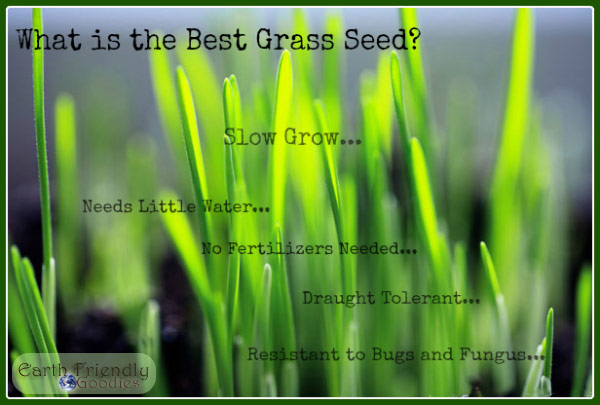
What is the Best Grass Seed?
I think I have found the best grass seed because I have the perfect lush green eco friendly lawn, well at least in my mind I do. And perhaps thanks to Eco-Lawn from Wildflower Farms that lush green grass I envision will become a reality. Oh, did I forget to mention my perfect eco lawn needs no watering, fertilizer, bug killer and only needs mowing once a month at most? Sounds to me like an Eco Lawn review is in order.
Is Eco-Lawn Really the Best Grass Seed Ever?
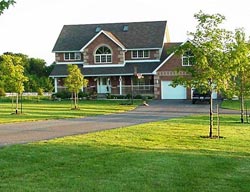
A lush Eco-Lawn, alas not mine
As hard as it is to believe that is what Eco-Lawn™ grass seed claims – eco-lawn grass seed is said to produce an extremely drought tolerant, low maintenance lawn.
Since the roots of this fine fescue grass blend grow 9-14 inches deep it crowds out any weeds (it is also allelopathic which means the grass exudes a natural herbicide to prevent weeds), and grows deep enough that harmful chemical fertilizers are not needed, plus an Eco-Lawn is naturally resistant to bugs, grubs and insects! If that doesn’t sound like the best grass seed ever I don’t know what is.
Actually I had heard similar good things about Zoysia grass seed, but after looking into it further I found out that Zoysia grass doesn’t grow well in cooler climates. Eco-Lawn™ is produced in Canada so if it grows that far north it will thrive in cooler climates. As far as growing in hot climates like Arizona – Wildflower Farms says it grows great, but you’ll need to water it maybe once a week – much less than traditional grass seed.
Reading all the claims and testimonials got me quite excited to try this low maintenance eco-friendly grass seed for myself to find out of it really is the best grass seed for my lawn and thanks to the fine folks at Wildflower Farm I get the chance to review Eco Lawn grass seed.
My Eco Lawn Grass Seed Experiment, and the Best Grass Seed Is…?

Before Eco-Lawn Seeding – What a Mess!
Since the front portion of our lawn was looking pretty burnt out I figured that would be a good place to start. The best time to plant grass seed is in the fall (for Northern climates), the second best time to plant grass seed is in the spring and like any kid with a new toy I couldn’t wait to start so the spring it is.
The Wildflower Farms website has lots of information about the best time to plant grass seed, the best grass seed for overseeding and installation tips for planting Eco-Lawn™ grass seed in particular. If you over seed a lawn like I was planning it can take a few years to get a completely established eco lawn, but since the lawn was pretty burnt out already we’ll see how it goes.
One tip for overseeding that I wish I had done was to de-thatch the lawn with a metal rake, but since it was spring they suggested not to do so because it stirs up the weed seeds. I found the weeds were plenty ready to pop up anyway so de-thatching the lawn seems like it would have helped the grass seed get established better as the areas where the thatch had been removed with a loose raking are coming up better. I may have to try another section of the lawn in the fall as a comparison.
Best grass seed for cooler climates: updates and overseeding tips
It has been a few weeks and some areas are coming up better than others, but so far things are looking good. I can tell though that with the overseeding method it will take lots of time and patience.
Stay tuned for my progress, I’ll let you know how things go… and someday perhaps the eco-friendly lush green lawn I envision will be the one I see out the window.
Update: Fall 2010
It is now fall and time for seeding number two. I can tell already the over-seeding method is going to take plenty of patience. There was an area of the lawn that I had to re-bury the sprinkler system (long story – don’t ask) and in that area I had covered it with compost. Over the summer the eco-lawn grass seed was coming up nice and thick in that area… problem was so was a mighty interesting collection of weeds. So here are a few observations and tips I would suggest.
Eco-Lawn Over Seeding Tips:
1. If you plan to over-seed make sure you have plenty of patience – it will take awhile.
2. For best results lay down a layer of compost and mix the seed into that – I strongly suggest you somehow pre-treat the compost for weeds. If anyone knows of a way to naturally prevent weed growth in composted soil please comment below – we’d all like to know!
3. Even though Wildflower Farms recommends you do not de-thatch the lawn with a metal rake for spring seeding I think I would have had better results if I had. The main reason they do not recommend it is because it stirs up the weed seeds, but I found both the compost covered area and the non-composted area were full of weeds anyway. Based on the areas of eco-lawn seed that were growing the best it was in areas that had looser soil.
Update: Spring 2011
A new season of Eco-lawn overseeding begins! Well, I’ve had a bit of a set back… we had some not so pleasant visitors over the winter – Moles! or voles or shrews or whatever those tunnel digging pests are that invaded my fall seeding. So my struggling patch looked like an ant farm if it was laid out over the lawn – lots of tracks and tunnels.
I laid down another run of eco-lawn grass seed so we’ll see how this next phase of the overseeding goes. I still hold firm on my advice to just bite the bullet and till your lawn before planting your eco-lawn grass seed – overseeding isn’t for the impatient. But then again from what I have heard from people that have gone the till and seed method there are challenges with that method as well.
Update: Spring 2012
I have to say my lawn had more issues than I was aware of – just look at the photo when I started and you’ll see what I mean. If you are starting from a similar point your best bet is to start from scratch, till the lawn and start with a fresh layer of eco lawn grass seed mixed in with a good dose of organic compost. After reviewing eco lawn grass seed for the past few seasons I think it is the best grass seed you will find if you are looking for a slow grow eco-friendly seed. But there is a caveat… you need to be patient, at least that is my experience. But look what I had to start from.
Before you plant eco lawn seed it would be a good idea to have the Ph of your soil tested. From there you can determine if your soil is healthy – the happier the soil the better and faster your eco lawn will grow.
For my eco-lawn review I am taking a step back and fixing some soil issues before I continue to seed. I am taking war out on the weeds by dousing the yard with corn meal gluten which is a natural pre-emergent (stops seeds from germinating – including grass seed unfortunately) but once your lawn is well treated with corn meal gluten for a couple seasons there won’t be as many competing weeds so I think the eco lawn grass seed will have an easier time getting established. That along with a good aeration and I’m hoping I’ll have better luck next season getting the green eco lawn I’m hoping for.
I’ll keep you posted on my progress to have that rich lush eco lawn as it continues…. Since my lawn was in pretty bad shape to start with I’d really like to hear what your eco grass overseading experience has been if you are starting with a “normal” green grass state. Please leave a comment below…
I Recently Discovered Another Slow Grow Grass Seed: Pearl’s Premium Grass Seed – Worth Taking A look At
Update: Fall 2012
I used up the last of my Eco-Lawn grass seed in my test patch overseeding experiment. But I did find a locally sold variety of slow grow fescue blend grass that I put over the rest of the lawn. Unfortunately, (why does there always have to be an unfortunately in this story) I had a sprinkler system leak that I was dealing with… (again, long story don’t ask) that delayed when I could have the lawn aerated.
So by the time I was able to seed I think it was getting too cold out for it to germinate properly. I guess we’ll find out in the spring.. Oh, and I discovered another reason I may be having difficulty getting my eco lawn established – we have pretty hard clay soil here which the seed is supposed to grow just fine in, but I am guessing it is pretty hard to get established if the ground is too hard… like when a core aerator set to 2 inches only pulls out half inch plugs.. that’s pretty hard soil.
I’m still convinced Eco-Lawn grass seed is a wonderful product – I just seem to have pretty unforgiving soil conditions to say the least. I hope you have better luck with your attempts to convert your lawn into a nice lush eco friendly lawn.
If you’ve tried converting your lawn to an eco lawn please comment below, I’d love to hear about your progress. And what is your opinion – is Eco-Lawn the best grass seed ever or have you found another slow grow grass seed you’d recommend?

 Earth Friendly Goodies If it's Good for the Earth it's Good for Your Health
Earth Friendly Goodies If it's Good for the Earth it's Good for Your Health 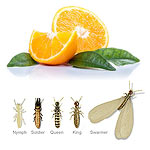
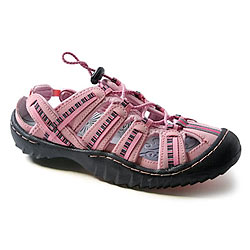
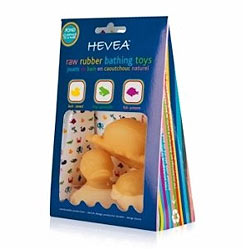

Only needs mowing once a month at the most?? Where do you live? Where i’m at that is UNHEARD of! There is just no way. I must mow once a week otherwise it gets out of hand and that is normal. Because it gets so hot around here, the grass requires a ton of water which, in turn, promotes growth like crazy. Once a month would be nice but only a reality in my dreams, i’m afraid.
I have to mow once a week for sure… begin of the season I do let it grow a bit to thicken up the grass.
Sounds too good to be true I know – I’m still waiting to get a nice lush eco-lawn, but because this type of grass grows so slowly you only need to mow every few weeks. Plus the roots are much deeper so it doesn’t need watering as often.
That is very interesting. I have done some more research on it and you’re exactly right. What an awesome species of grass! I checked out your Solar Tiki Torches.. My in-laws have decorated their outdoor pool with tiki torches but they’re pretty old and ruggid looking. I’ll have them check these babies out! Pretty cool!
Thanks Sprinkler Buff, I hope they find some that will work for them – they are so much easier to handle than traditional tiki torches, sure the ambiance of a real flame is nice but they do have some disadvantages over a nice set and forget solar set. Glad you learned more about eco-lawn as well – it sure would be nice if more lawns took advantage of a slow grow grass seed. Without getting too eco-geeky that’s a lot of water and harmful fertilizer that wouldn’t need to be used. 🙂
Yes, it does not grow too much and if you don’t mow it i falls over itself very beautifully. See picture http://media.eartheasy.com/media/catalog/product/cache/1/image/9df78eab33525d08d6e5fb8d27136e95/e/c/eco-lawn-boulevard-shot.jpg
Thanks for sharing a photo Keith – looks nice!
Great information! This should make my lawn nice and luscious.
Lawn care really is tricky business! We’ve gotten so used to using chemicals to care for our lawns that it’s become a challenge to do it in a “green” way. Keep the updates coming!
You are exactly right, this is very interesting, very useful information.
I am going to be seeding in the Fall, but will add 4 inches of topsoil and a 1/4″ of compost. Hopefully, starting from scratch will be easier than overseeding. My existing yard is a mess–the fescue just doesn’t hold up in these hot, humid VA summers. I have dirt by the end of July. And, speaking of the moles, get some VICTOR “OUT OF SIGHT” mole traps. I spent thousands of dollars and had my entire lawn dug up before I saw these on Amazon. I bought 6 of them, followed the directions of the people in the reviews and caught 8-10 in days!! It solved my problems.
I think you’ll have much better luck with that Cindy, I’m sure it still takes some work doing that way but I think it will work out better for you. Just remember it needs a lot of water initially and then once the eco-lawn is established it shouldn’t need nearly as much as other grasses. Thanks for the mole tip as well so far they haven’t returned but I’ll keep that in mind. 🙂
If you can avoid it, don’t till! Hubby and I did, and for most of the backyard, the weeds (all different sorts coming up at different times) out-grew the eco-lawn. When I cut some down by hand, I could see tiny eco-lawn grass growing with the weeds, so I know they are somehow growing, too.
We’ve over-seeded once and the eco-lawn seems to be growing much faster in the shady areas of the yard. I experimented by casually throwing some seed beside our front porch. Never watered it, and a couple weeks later, that side has the most lush, greenest eco-lawn than any other part of my yard.
If I could do it all over again, I would have been more patient and used this past season to treat my yard and get rid of all the weeds, and waited until next spring to sow the eco-lawn seeds.
But husband and I were too impatient. Now we’re looking at several seasons of overseeding before we can have a decent-looking, eco-friendly yard.
Thanks for your input Lexi – I think we are in the same boat but from two different angles. 🙂 It seems that one has to be patient no matter which way you go about attempting an eco lawn -tilling or overseeding.
Those darn weed seeds abound by the millions in the soil so treating the soil to prevent as many weeds as possible would be a good first step – I’m currently trying corn meal gluten which prevents any seed from germinating (for 3 months) so I use that in the spring and I’ll be seeding now in the fall after I aerate the lawn. It is going to be a long journey.
Good luck on your eco-lawn adventures – let us know how it goes. 🙂
Very interesting! I have been a landscaper for 8 years, and I have heard so much about Eco-Lawn grass seeds, but I have never actually tried it out. I can just imagine all the hard work you’re putting into this project. It’s not easy to start from scratch, and like you said, patience is essential when you’re trying to establish a beautiful lawn. No matter how good the grass seeds are, if we don’t have the patience to prep the soil, we’re still never going to get that lush, eco-green lawn of our dreams. Looking forward to read about your updates!
Thanks Lawn Guy – I wish I had read your article before I had my lawn aerated recently – great tips, although the only one under my control since I had a company do it would be to water the lawn thoroughly before it is aerated.
I agree with lawnguy. Here in western Colorado we deal with adobe soils that have few nutrients in them. We also have to water a lot for any species of grass. We only get around 13 inches of precipitation per year. It makes having a sprinkler system crucial. I would be curious how this seed would do in our neighborhood. The other drought tolerant species still have to be sprinkled to stay green here.
I live in a very dry climate in Alberta Canada. And can tell you that Eco-lawn requires way less water. Like any seeds it requires plenty of water to get going but once it was a couple of weeks old it staid lush and green while all the surrounding (non eco-lawn) lawns which were years old were mainly brown. Of course if you are somewhere really dry and hot where you don’t find much lawn growing naturally (e.g., Arizona dessert) you will have to water even when its established. Likewise, if your locality is experiencing a severe drought (no rain at all for many weeks). But Eco-lawn is great as Daniel has described below. I know Wildflower Farm (producers of Eco-lawn) can often provide references in your area where you can often go and visit established lawns in your area. So that may be a possibility for you if you have doubts.
Thanks to your article, I know about a kind of lawn that help me to save money, effort and water in maintenance. I also happy that using this kind of lawn is a great way to protect the environment.
I have been using Eco-Lawn grass seeds for a long time and it is one of the best products I have ever bought. Anyway, thanks for your tips!